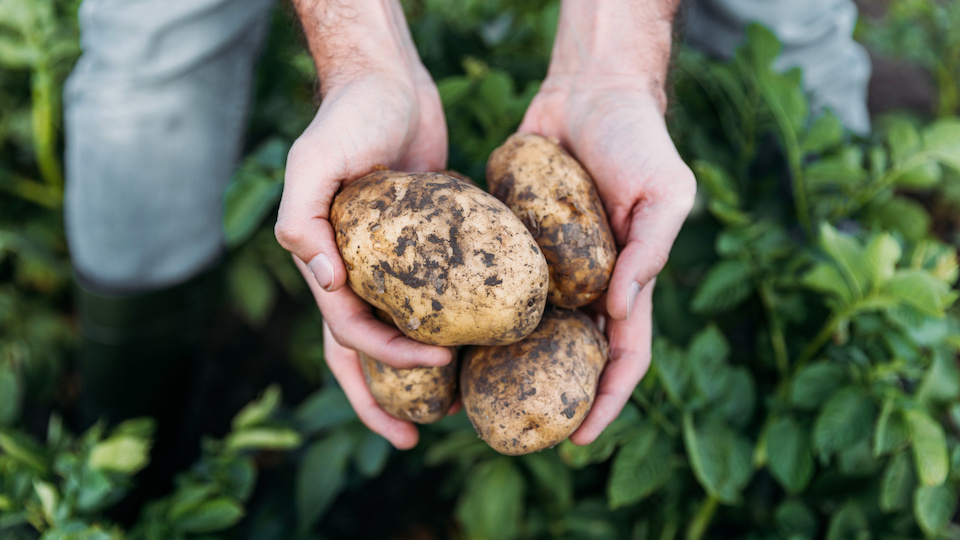Potatoes are one of those staple foods that you should always have on hand. They last for a long time (especially when stored properly), are super filling, and can be incorporated into a wide variety of dishes. Plus, they are incredibly easy to grow, even in a tiny space like a balcony, porch, or small yard. All you need is some soil and a few five-gallon buckets, and you are well on your way to a bountiful potato harvest.
Step 1: Gather your seed potatoes
Potatoes aren’t grown from seed like other veggies. To grow your own potato plant in a bucket, you will need sprouted seed potatoes, which will grow into mature plants and produce more tubers. Though you can technically plant potatoes that you buy from the grocery store, you will usually have more success if you purchase your starter potatoes from a nursery or online seed company. Many grocery store potatoes are treated with sprout-stopping chemcials, which can make them difficult to grow.
Once you get your potatoes, you will need to leave them in a light, cool place for a few weeks so that they can sprout. Simply leave them in an egg carton with the eyes facing up until they produce sprouts that are about an inch tall.
Step 2: Prepare your container
If you’re looking for a forgiving veggie that will grow pretty much anywhere, then potatoes are a perfect choice. Be sure to choose a container with good drainage (or make your own drainage holes using a drill or other sharp object) that isn’t clear, as developing potato tubers don’t like to be exposed to the sun. Black buckets can also be detrimental if you live in a hot area so avoid those as well. You can even use potato sacks that are specifically designed for growing these hearty veggies or simple burlap sacks, if desired. My personal favorite container is a good, old fashioned 5-gallon bucket from a hardware store like Lowes or Home Depot.
It’s cheap, easy to find, and portable due to the convenient carrying handle. Keep in mind, you won’t necessarily want to move your potato bucket once it’s full of soil and veggies, but it’s nice to have that option. Remember, each potato plant needs about 2.5 gallons of space, so that’s two plants per five-gallon bucket. With proper care and harvesting (and assuming that both of the plants are healthy), each bucket could produce between eight and 10 pounds of yummy, homegrown potatoes.
Step 3: Fill with soil
The best soil for planting potatoes is loose, well-drained loam soil. Stay away from heavy clay, which can become too compacted and sandy soil that doesn’t retain water. It’s always a good idea to mix your soil blend with rich, organic compost to provide a nutrient boost for your hardworking plants and help ensure healthy growth.
Before you start dumping in soil, consider adding a thin layer of rocks or gravel in the bottom of the bucket to help ensure that the drainage holes do not become blocked by compacted soil. Next, add soil to your bucket until there is about four to six inches in the bottom. Then, add your potatoes by lightly pushing them into the soil (sprouts facing up) and cover with another three or four inches of your soil mixture.
Step 4: Ensure light and water requirements are met
Like most vegetables, potatoes prefer direct sunlight and will do best in an area that is exposed to at least six hours of bright light each day. Water regularly, but not too often as potatoes can rot if left in soggy soil. Soil should stay moist a few inches beneath the surface.
Step 5: Cover with more soil
The best thing about growing potatoes in buckets is that you can maximize vertical growth in a small area. As your potato plants grow, you will want to continue covering them with soil so that they will set new tubers along the way as they reach the top of the bucket. Once your plant is about four to six inches above the soil, add more until just the tip of the plant is sticking out of the dirt. Repeat as the plant grows.
Step 6: Harvest
Once your potato plant blooms, it’s time to start harvesting. Before it dies back completely, you can carefully dig your hand into the soil and pluck off any potatoes that are about the size of an egg to enjoy an early harvest of new potatoes, while letting the rest continue to grow. When the foliage finally dies, empty your bucket (preferably on a tarp to make cleanup easier) and search through the soil to harvest all of your healthy, delicious spuds.
Note: Though potatoes should grow and produce a bountiful harvest in rich soil with amended compost, adding a weekly compost tea or low-nitrogen fertilizer will encourage even more growth and will help your potatoes stay strong and healthy.
-Susan Patterson



